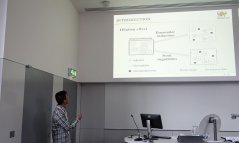
Project
Is the dilution effect true?
Zheng Huang studied the relationship between species richness and infectious disease risk, in particular the generality and importance of the so-called dilution effect, using a modelling approach. Zheng defended his thesis on 29 September 2014.
Disease-diversity interactions is one of the central question in disease ecology. It has been hypothesized that species diversity is able to reduce pathogen transmission, i.e. the dilution effect. Although mounting evidences have been found for the dilution effect, it is still highly disputed whether the dilution effect generally occurs.
Project description
Species diversity has been postulated to influence the risk of infectious diseases. In theory, changes in species richness or diversity in communities can lead to a dilution effect or amplification effect by changing the abundance of competent hosts or altering the encounter rates among competent hosts in a community (Keesing et al., 2006). Dilute effect, which is described as that the species diversity can reduce disease risk, is a quite fascinating hypothesis linking nature conservation and disease transmission. This dilution effect can operate through different mechanisms, such as decreasing encounter rates among competent hosts or regulating host abundance (Keesing et al., 2006).
This PhD project is aimed at understanding the effect of species richness on disease risk, especially the generality and importance of the dilution effect. The whole project is divided as several chapters:
1. Test the dilution effect in bovine tuberculosis (BTB) (finished): Based on the BTB data in Africa from OIE, we tested the relationship between mammal species richness and BTB risk (presence/persistence/recurrence) at regional scale. We also tested other factors associated with BTB risk. Our results suggested a dilution effect that higher mammal species richness associated with lower BTB risk after controlling for cattle density. This dilution effect might be explained by the encounter reduction, where those incompetent mammal hosts and non-hosts can act as physical barriers to herd movements and thus reduce contact rates among cattle herd.
Huang ZYX, de Boer WF, van Langevelde F, Xu C, Ben Jebara K, Berlingieri F, Prins HHT. 2013. Dilution effect in bovine tuberculosis: risk factors for regional disease occurrence in Africa. Proceedings of the Royal Society B: Biological Series 280: 20130624 Full text
2. Test the dilution effect in avian influenza in Europe (ongoing): As a direct-transmitted disease, avian influenza (H5N1) can infect many water birds and spread among them. Although many risk factors have been identified for H5N1 outbreaks, few studies tried to investigate on the effect of bird species richness and density due to the lack of bird data. Collaborating with Wetlands International, we will detect the effect of bird species richness and density on H5N1 outbreaks.
3. Test the relationship between species' reservoir competence and life-history traits which link to local extinction risk (finished): Life history theory generally suggests trade-offs with investment in self-maintenance (e.g., physiological resistance) at the expense of other physiological activities, such as current reproduction and growth. The predictions derived from this theory suggest that “fast-lived” species (i.e. species that follow a strategy aimed at growth and early reproduction) tend to invest minimally in adaptive immunity, which may make them more competent for pathogens, whereas “slow-lived” species with longer life spans and slower growth rates are hypothesized to invest more into costly immune defences. In this study, our results showed that reservoir competence can be partly explained by species’ life-history traits. Considering life-history traits has been linked to local extinction risk, our results suggested a possible mechanism underlying the dilution effect
Huang ZYX, de Boer WF, van Langevelde F, Olson V, Blackburn TM, Prins HHT. 2013. Species’ life-history traits explain interspecific variation in reservoir competence: a possible mechanism underlying the dilution effect. PloS One 8(1): e54341 Full text
4. Simulate the dilution effect (the effect of alternative host species on disease risk) in metapopulations (ongoing): Fragmentation can lead to diversity loss, which can increase disease risk due to the release of the dilution effect. On the other hand, fragmentation is able to reduce the connectivity of the habitat, which can influence the spread and persistence of the pathogen. In this study, we investigate the how disease risk changes, due to the change of importance of the dilution effect and connectivity’s facilitation effect, along increasing connectivity in a metapopulation.
Other publications:
Xu C & Huang ZYX, Chi T, Chen BJW, Zhang M, Liu M. 2013. Can local landscape attributes explain species richness patterns at macroecological scales? Global Ecology and Biogeography. (co-first author)
Xu C, Liu MS, Zhang M, Chen B, Huang Z, Uriankhai T, Sheng S. 2011. The spatial pattern of grasses in relation to tree effects in an arid savannah community: Inferring the relative importance of canopy and root effect. Journal of arid environment 75: 953-959
Xu C, Liu MS, Yang XJ, Sheng S, Zhang MJ, Huang Z. 2010. Detecting the spatial differentiation in settlement change rates during rapid urbanization in the Nanjing metropolitan region, China. Environmental Monitoring and Assessments 171: 457-470.